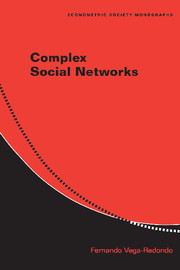Book contents
- Frontmatter
- Contents
- Preface
- 1 Introduction
- 2 Complex Networks: Basic Theory
- 3 Epidemic Diffusion
- 4 Neighborhood Effects in Diffusion and Play
- 5 Searching in Social Networks
- 6 Search, Diffusion, and Play in Coevolving Networks
- Afterword
- A Generating Functions
- B The Ising Model
- C Mean-Field Theory
- Bibliography
- Index
- Econometric Society Monographs
3 - Epidemic Diffusion
Published online by Cambridge University Press: 05 January 2013
- Frontmatter
- Contents
- Preface
- 1 Introduction
- 2 Complex Networks: Basic Theory
- 3 Epidemic Diffusion
- 4 Neighborhood Effects in Diffusion and Play
- 5 Searching in Social Networks
- 6 Search, Diffusion, and Play in Coevolving Networks
- Afterword
- A Generating Functions
- B The Ising Model
- C Mean-Field Theory
- Bibliography
- Index
- Econometric Society Monographs
Summary
This chapter initiates our study of diffusion and models it as a process whose spreading mechanism is independent of any neighborhood considerations. This means that the procedure by which the process propagates from a certain node to any one of its neighbors is unaffected by the conditions prevailing in the neighborhoods of those two nodes – thus, in particular, it is unrelated to the states displayed by their other neighboring nodes. In this sense, one can conceive the phenomenon as akin to biological infection, a process that is often mediated through local contact at a rate that depends on the aggregate exposure to infected neighbors. With this analogy in mind, we shall label such a process as epidemic diffusion. But, of course, diffusion in socioeconomic environments is often different, subject to neighborhood (as well as payoff-related) considerations. To study it under these conditions, therefore, we need a different framework of analysis, which is introduced in Chapter 4.
ALTERNATIVE THEORETICAL SCENARIOS
Epidemiology is an old and well-established field of research, both empirical and theoretical. Its canonical models fall into two categories:
SIR (susceptible-infected-recovered), where the life history of each node (or agent) passes from being susceptible (S), to becoming infected (I), to finally being recovered (R), always moving in a unidirectional fashion.
SIS (susceptible-infected-susceptible), where each node passes from being susceptible (S) to turning infected (I), to becoming again susceptible (S), thus allowing for a bidirectional transition between the two possible states.
- Type
- Chapter
- Information
- Complex Social Networks , pp. 75 - 108Publisher: Cambridge University PressPrint publication year: 2007



